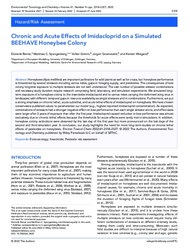Chronic and Acute Effects of Imidacloprid on a Simulated BEEHAVE Honeybee Colony
DOI: https://doi.org/10.1002/etc.5420
Persistent URL: http://resolver.sub.uni-goettingen.de/purl?gldocs-11858/10259
Persistent URL: http://resolver.sub.uni-goettingen.de/purl?gldocs-11858/10259
Supplement: https://doi.org/10.5281/zenodo.6567312
Reiner, Dominik; Spangenberg, Matthias C.; Grimm, Volker; Groeneveld, Jürgen; Wiegand, Kerstin, 2022: Chronic and Acute Effects of Imidacloprid on a Simulated BEEHAVE Honeybee Colony. In: Environmental Toxicology and Chemistry, Band 41, 9: 2318 - 2327, DOI: 10.1002/etc.5420.
 |
Dokument öffnen: |
Honeybees (Apis mellifera) are important pollinators for wild plants as well as for crops, but honeybee performance is threatened by several stressors including varroa mites, gaps in foraging supply, and pesticides. The consequences of bee colony longtime exposure to multiple stressors are not well understood. The vast number of possible stressor combinations and necessary study duration require research comprising field, laboratory, and simulation experiments. We simulated long‐term exposure of a honeybee colony to the insecticide imidacloprid and to varroa mites carrying the deformed wing virus in landscapes with different temporal gaps in resource availability as single stressors and in combinations. Furthermore, we put a strong emphasis on chronic lethal, acute sublethal, and acute lethal effects of imidacloprid on honeybees. We have chosen conservative published values to parameterize our model (e.g., highest reported imidacloprid contamination). As expected, combinations of stressors had a stronger negative effect on bee performance than each single stressor alone, and effect sizes were larger after 3 years of exposure than after the first year. Imidacloprid‐caused reduction in bee performance was almost exclusively due to chronic lethal effects because the thresholds for acute effects were rarely met in simulations. In addition, honeybee colony extinctions were observed by the last day of the first year but more pronounced on the last days of the second and third simulation year. In conclusion, our study highlights the need for more long‐term studies on chronic lethal effects of pesticides on honeybees. Environ Toxicol Chem 2022;41:2318–2327. © 2022 The Authors. Environmental Toxicology and Chemistry published by Wiley Periodicals LLC on behalf of SETAC.
Statistik:
ZugriffsstatistikSammlung:
This is an open access article under the terms of the Creative Commons Attribution‐NonCommercial License, which permits use, distribution and reproduction in any medium, provided the original work is properly cited and is not used for commercial purposes.

